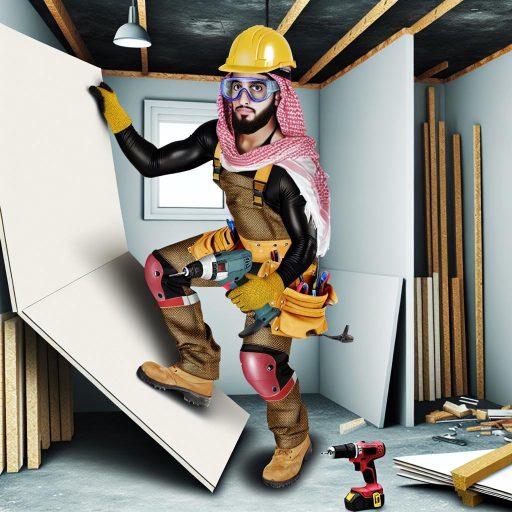Introduction:
A professional machinist is responsible for operating machinery to create precision metal parts.
Machinists play a crucial role in various industries, such as automotive, aerospace, and manufacturing.
Their work ensures that products meet strict quality standards and specifications.
Starting the Day:
As a professional machinist, the day typically begins with reviewing work orders and blueprints.
Setting up machines and selecting the appropriate tools are essential for the day’s tasks.
Operating Machinery:
Throughout the day, machinists use lathes, milling machines, and grinders to shape and cut metal parts.
They carefully monitor the process to ensure accuracy and quality in the finished product.
Quality Control:
Inspecting finished parts is a critical part of a machinist’s job.
They use precision measuring instruments to ensure dimensions meet specifications.
Any discrepancies must be addressed promptly.
Problem Solving:
Challenges may arise during machining, requiring machinists to troubleshoot and find solutions.
This could involve adjusting machine settings or using different techniques to achieve the desired outcome.
Collaboration:
Communication with colleagues, supervisors, and engineers is essential for a machinist.
Providing input on designs and suggesting improvements helps optimize the manufacturing process.
End of the Day:
Wrapping up the day involves cleaning work areas, maintaining equipment, and preparing for the next shift.
Reflecting on the day’s accomplishments and challenges is also important for personal growth.
Importance of Machinists in Industries:
Professional machinists play a vital role in ensuring the efficiency and quality of metal parts in various industries.
Their precision work and problem-solving skills contribute to the overall success of manufacturing processes.
Education and Training
When it comes to becoming a professional machinist, there are specific educational requirements that need to be met in order to excel in this field.
Let’s dive into the details of what it takes to become a skilled machinist.
Transform Your Career Today
Unlock a personalized career strategy that drives real results. Get tailored advice and a roadmap designed just for you.
Start NowEducational Requirements
- A high school diploma or equivalent is typically required to pursue a career as a machinist.
- Post-secondary education in machining or a related field is highly recommended for those looking to advance in their careers.
- Many community colleges and technical schools offer certificate or degree programs in machining.
Having a solid foundation in mathematics, blueprint reading, and precision measurement is crucial for success in this field.
Machinists must be able to interpret complex technical drawings and use precise measurements to create parts that meet exact specifications.
Types of Training Programs Available
- Apprenticeship programs are a common pathway for individuals looking to become machinists.
- These programs typically combine on-the-job training with classroom instruction to provide a well-rounded education.
- Technical schools and community colleges also offer training programs that focus on hands-on experience with machine tools and equipment.
Hands-on experience is essential for machinists, as they need to be proficient in operating a variety of machine tools, such as lathes, milling machines, and grinders.
Understanding the capabilities of different machines and how to program them is critical for producing high-quality parts.
Importance of On-the-Job Training
- On-the-job training is a crucial component of becoming a skilled machinist.
- Working alongside experienced professionals allows new machinists to learn best practices and gain practical skills.
- Hands-on experience in a manufacturing environment is invaluable for developing proficiency in machining techniques.
Machinists often start in entry-level positions and gradually work their way up to more advanced roles as they gain experience and demonstrate their proficiency.
Continuous learning and adapting to new technologies are essential in this field, as advancements in machining techniques and equipment are constantly evolving.
The education and training required for becoming a professional machinist are rigorous and demanding, but the rewards of mastering this skilled trade are well worth the effort.
As a professional machinist, each day presents a unique set of challenges and responsibilities that require a high level of skill and expertise.
Let’s delve into the intricacies of the job duties to gain a deeper understanding of what a day in the life of a machinist entails.
Job Duties:
- Performing typical tasks involved in a machinist’s daily routine.
- Operating and maintaining machine tools throughout the day.
- Reading and interpreting blueprints to execute precise machining processes.
Typical Tasks Involved
Throughout the day, machinists are tasked with a variety of responsibilities that require precision and attention to detail.
These tasks may include setting up and adjusting machines for production, monitoring the operation of machinery, and inspecting finished products to ensure they meet quality standards.
Machinists often work with a wide range of materials, such as metal, plastics, and ceramics, using various machine tools such as lathes, milling machines, and grinders.
They must be knowledgeable about the properties of different materials and understand how they will react to the machining process.
Operating and Maintaining Machine Tools
One of the primary duties of a machinist is operating and maintaining machine tools throughout the day.
This involves setting up and programming machines, monitoring their performance, and making adjustments as needed to ensure the proper functioning of the equipment.
Machinists are also responsible for performing routine maintenance on machines to prevent breakdowns and ensure they are operating at optimal levels.
This may involve cleaning and lubricating machines, replacing worn parts, and troubleshooting any issues that arise during production.
Reading and Interpreting Blueprints
Another essential skill for a machinist is the ability to read and interpret blueprints, which are detailed technical drawings that outline the specifications for a part or component.
Machinists use these blueprints to understand the dimensions, tolerances, and materials required for a specific job.
Showcase Your Business Today
Reach thousands of readers actively exploring professional services. Publish your business profile and grow your audience now.
Publish NowBy carefully studying blueprints, machinists can determine the necessary machining processes and select the appropriate tools and techniques to achieve the desired outcome.
They must be able to accurately translate the information on the blueprint into precise actions that result in a finished product that meets the customer’s specifications.
Discover More: Daily Life of an Ironworker on Construction Sites
Work Environment:
Different settings where machinists work (e.g. manufacturing plants, machine shops).
Safety protocols and regulations.
Collaborating with engineers and other professionals.
Manufacturing Plants and Machine Shops:
Machinists can be found working in a variety of settings, from large manufacturing plants to small machine shops.
Each environment offers unique challenges and opportunities for machinists to showcase their skills.
Safety Protocols and Regulations:
Safety is of utmost importance in the machining industry.
Machinists are required to follow strict safety protocols and regulations to ensure their well-being and the safety of those around them.
This includes wearing appropriate protective gear, using machinery properly, and adhering to safety procedures at all times.
Collaborating with Engineers and Other Professionals:
Machinists often collaborate with engineers and other professionals to design and produce precision parts.
This collaboration is crucial in ensuring that the final product meets the required specifications and standards.
Machinists work closely with engineers to interpret technical drawings and blueprints, make adjustments as needed, and troubleshoot any issues that may arise during the machining process.
Explore Further: Safety Tips for Waste Management Professionals
Tools and Equipment
Professional machinists rely on a variety of tools and equipment to produce precision parts and components.
Here is an overview of the essential tools used in machining:
Lathe
- One of the most fundamental tools in a machinist’s arsenal.
- Used for turning, facing, drilling, and threading operations.
- Precision cuts are achieved by adjusting speed and feed rate.
Milling Machine
- Allows machinists to create complex 3D shapes and profiles.
- Uses rotary cutters to remove material from a workpiece.
- Can perform both manual and CNC operations.
Drill Press
- Essential for drilling accurate holes in various materials.
- Available in both benchtop and floor-standing models.
- Offers precise control over spindle speed and depth of cut.
Accuracy and precision are paramount in machining as even the slightest deviation can result in faulty parts.
Machinists must possess a keen eye for detail and a steady hand to ensure that every piece meets the required specifications.
As technology advances, machinists are constantly upgrading their tools and equipment to keep up with the latest advancements.
Many shops are integrating computer numerical control (CNC) machines and software to improve efficiency and accuracy in their operations.
By embracing new technologies and software, machinists can streamline their workflows, reduce lead times, and enhance the quality of their output.
However, it is essential for machinists to undergo training and stay updated on the latest trends in order to fully leverage these advancements.
Learn More: Agricultural Worker Safety Tips for Every Season
Problem Solving:
Working as a professional machinist comes with its fair share of challenges.
Let’s delve into some of the common issues faced by machinists on the job and how they tackle them with problem-solving skills:
Common challenges faced by machinists:
- Dealing with complex and intricate blueprints
- Tight deadlines and pressure to deliver quality results
- Ensuring precision and accuracy in measurements
- Handling difficult materials like titanium or hardened steel
- Maintaining and calibrating equipment regularly
Troubleshooting machine malfunctions:
- Identifying the root cause of the issue
- Checking for loose bolts or worn-out parts
- Consulting technical manuals and experts for guidance
- Performing routine maintenance to prevent breakdowns
- Adjusting settings and parameters for optimal performance
Using critical thinking skills to improve processes:
- Analyzing workflow and identifying bottlenecks
- Suggesting changes to enhance efficiency and productivity
- Testing new tools and techniques to streamline operations
- Implementing safety measures to reduce risks and accidents
- Collaborating with colleagues to brainstorm innovative solutions
Machinists rely on their problem-solving abilities to navigate through various challenges in their daily work.
By staying adaptable and resourceful, they ensure smooth operations and high-quality output in the manufacturing industry.
Gain More Insights: Waste Management Worker Tools and Safety Gear

Career Opportunities for Professional Machinists
Professional machinists have a variety of career opportunities available to them.
With the right skills and experience, they can advance in their field and explore various specializations.
Advancement Opportunities
- Machinists can advance to senior or supervisory roles.
- They may also become quality control inspectors or production managers.
- With additional training, they can move into engineering or design positions.
Specializations within the Field
- CNC Machinists: These professionals operate computer numerical control machines.
- Tool and Die Makers: They specialize in making and repairing tools and dies used in manufacturing.
- Programmers: These experts focus on creating programs to control machine operations.
Potential for Growth in the Industry
- The manufacturing industry is constantly evolving, creating new opportunities for machinists.
- As technology advances, machinists with specialized skills are in high demand.
- Globalization has also increased the need for skilled machinists who can work on international projects.
Professional machinists have a promising future with numerous career paths to explore.
There is ample room for growth within the industry.
Salary and Benefits:
Average salary range for machinists:
As a professional machinist, salary can vary based on experience.
Entry-level machinists can expect to earn around $30,000 to $40,000 per year.
However, with more experience and specialized skills, machinists can earn upwards of $60,000 to $80,000 annually.
Benefits offered by employers (e.g. healthcare, retirement plans):
Employers often provide comprehensive benefits packages to attract and retain skilled machinists.
These benefits typically include healthcare coverage, dental and vision insurance, as well as retirement plans such as 401(k) contributions.
Union representation and bargaining power:
Many machinists are represented by labor unions that advocate for fair wages, benefits, and working conditions.
Unionized machinists have the advantage of collective bargaining power, allowing them to negotiate better contracts with employers.
Showcase Your Business Today
Reach thousands of readers actively exploring professional services. Publish your business profile and grow your audience now.
Publish NowWork-Life Balance:
As a professional machinist, maintaining a healthy work-life balance is essential to avoid burnout and ensure overall well-being.
Typical work hours and schedules for machinists:
- Machinists typically work full-time hours, which can range from 40 to 50 hours per week.
- Shifts may vary, with some machinists working during the day and others working night shifts.
- Overtime may be required, especially during peak production periods or urgent orders.
Importance of work-life balance in a demanding profession:
- Machining is a physically and mentally demanding profession that requires focus and attention to detail.
- Without a proper work-life balance, machinists may experience fatigue, stress, and decreased productivity.
- Investing time in personal hobbies, exercise, and relaxation can help prevent burnout and maintain overall health.
Strategies for managing stress and maintaining well-being:
- Set boundaries between work and personal life to prevent work from encroaching on your free time.
- Practice mindfulness techniques such as deep breathing or meditation to reduce stress and increase focus.
- Engage in regular exercise to improve physical health and reduce the negative effects of a sedentary work environment.
- Make time for social interactions with friends and family to maintain emotional well-being and support systems.
By prioritizing work-life balance and implementing effective stress management strategies, machinists can optimize their performance on the job while also taking care of their mental and physical health.
Recap of the Key Points Discussed:
In this blog post, we explored a typical day in the life of a professional machinist.
We discussed the tasks involved, the skills required, and the challenges faced.
Encouragement for Aspiring Machinists:
For those who aspire to pursue a career in machining, it is essential to develop a strong foundation in technical skills and problem-solving abilities.
Dedication and passion for precision work are key.
Acknowledgment of the Hard Work and Dedication:
Professional machinists play a vital role in manufacturing industries, contributing to the production of complex parts and components.
Their hard work, attention to detail, and commitment to quality are commendable.
Keep striving for excellence!
Additional Resources
A new study measures the actual impact of robots on jobs. It’s …
U.S. Navy Machinist Mate Careers | Navy.com
[E-Books for Sale]
The Big Book of 500 High-Paying Jobs in America: Unlock Your Earning Potential
$19.99 • 500 High-Paying Jobs • 330 pages
Explore 500 high-paying jobs in America and learn how to boost your career, earn more, and achieve success!
See All 500 High-Paying Jobs of this E-Book
1001 Professions Without a Degree: High-Paying American Jobs You Can Start Now
$19.99 • 1001 Professions Without a Degree • 174 pages
Discover 1001 high-paying jobs without a degree! Unlock career tips, skills, and success strategies for just $19.99!




